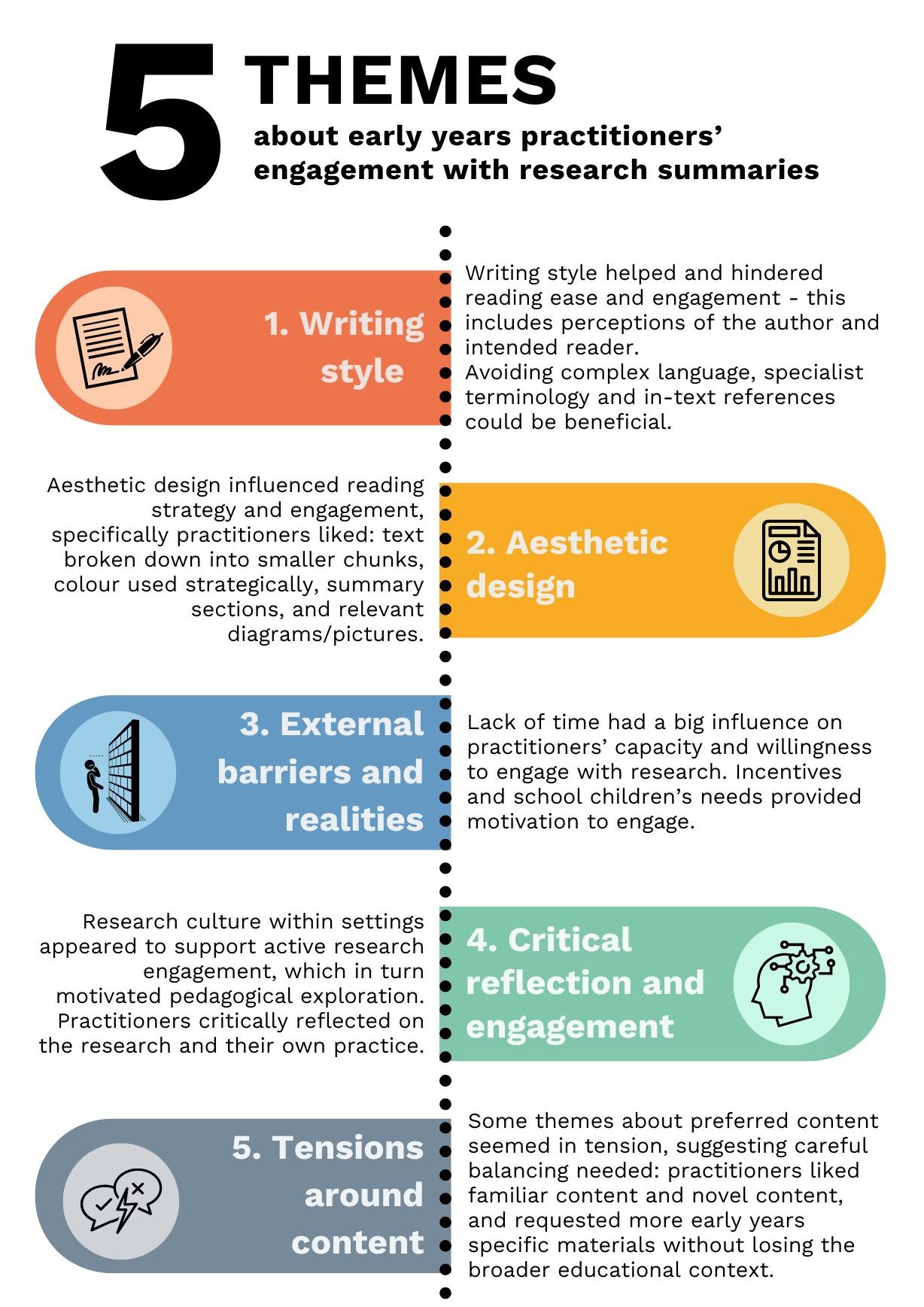How Early Years Practitioners Engage with Research Summaries
Dr Bethany Woollacott is a postdoctoral research associate at the Centre for Early Mathematics Learning at Loughborough. Beth’s primary focus is investigating how we can narrow the gap between research and practice through effective research communication. She is interested in making educational research more accessible and relevant to education practitioners. Edited by Dr Colin Foster.
In this blog post, Beth reviews her recently published paper which explores how eight early years practitioners engaged with research summaries, shedding light on the barriers and facilitators of effective research communication in their eyes. From a series of interviews, Beth identifies key challenges—including time constraints, complex language and presentation issues—while also highlighting how well-designed summaries can support educators in applying research to practice and critically reflecting on the research and their practice. These insights offer practical guidance for researchers, knowledge-brokers and policymakers striving to bridge the research-practice divide.
Introduction
The gap between educational research and classroom practice is a long-standing challenge. Research findings can have a real impact on teaching and learning, but only if educators can access and engage with them. Many organisations now produce research summaries to make findings more accessible, yet there is little evidence that these are effective.
This blog post explores the perspectives of early years practitioners—an underrepresented group in education research—on research summaries. What makes a summary engaging? What prevents educators from using the research discussed in their practice? And most importantly, how can we improve research communication to ensure it is truly useful for educators?
Why Focus on Research Summaries?
Research summaries are increasingly used to bridge the gap between researchers and educators. However, most summaries are not designed with early years practitioners in mind. Much of the existing research on research-practice communication focuses on primary and secondary teachers, potentially neglecting the perspectives of early years practitioners.
This study set out to explore how early years practitioners interact with research summaries, identifying key factors that influence engagement.
Analysis and Key Findings
After collecting the interview data from each of the eight early years practitioners, I thematically analysed the transcripts using reflexive thematic analysis1. Using this approach, it is important to acknowledge that my role as a researcher is an inherent part of this process where meaning does not reside in the data but is made by how I engage with it. My own perspectives and experiences will have inevitably influenced the themes that I identified during this process and this is seen as a strength, aiming to generate discussion and ideas for further research in this area.
I present the five main findings in an infographic format below.

Educational Impact: What can researchers do to support early years practitioners?
1. Improve Research Summary Design
Research summaries should be created with educators in mind. Practical strategies include:
- Writing in clear, accessible language which is not technical
- Using visuals and structured layouts (using colour or text blocking) to aid comprehension
- Minimising in-text referencing in favour of giving references at the end – don’t just remove references
- Reflecting on the relevance and timeliness of the information being communicated
2. Make Research Easier to Access
Given that time constraints are a significant barrier – and one which is often mentioned – research summaries could aim to be:
- Concise, focussing on the core components needing to be communicated
- Actionable: with clear support or examples of practical implications (where appropriate)
- Formatted for quick reading: considering how instructional design features (such as colour or text blocking) can support educators in easily understanding the material
3. Involve Educators in Research Communication
Involving educators in the development of research summaries could ensure that they meet educators’ needs more effectively. This is true at any stage of the research, where taking account of educators’ views could hugely improve the relevance and usefulness of research from the outset.
At this point, I would like to emphasise that these findings and recommendations (particularly this one) are not necessarily applicable to all types of research: some research is valuable from a theoretical or methodological perspective, and does not necessarily have real-world applications – and nor should we expect it to.
4. Consider the specific challenges that early years practitioners face
Although our findings predominantly reflected those in the existing literature with primary and secondary teachers, a key difference was that early years practitioenrs reported finding that the majority of research failed to account for children who could not yet read or write. Therefore, it is important to consider which age range your research applies to, and whether there are any practical implications that you could suggest which do not require reading or writing skills.
Conclusion
Effective research communication is essential for bridging the gap between research and practice. This study highlights key areas for improvement, showing that well-designed, relevant, and accessible research summaries can help early years practitioners engage with educational research more effectively.
Disclaimer: A ChatGPT model was used to support the writing of this blogpost. For more information, contact b.woollacott@lboro.ac.uk
References
- Braun, V., & Clarke, V. (2019). Reflecting on reflexive thematic analysis. Qualitative Research in Sport, Exercise and Health, 11(4), 589–597. https://doi.org/10.1080/2159676X.2019.1628806
Centre for Mathematical Cognition
We write mostly about mathematics education, numerical cognition and general academic life. Our centre’s research is wide-ranging, so there is something for everyone: teachers, researchers and general interest. This blog is managed by Joanne Eaves and Chris Shore, researchers at the CMC, who edits and typesets all posts. Please email j.eaves@lboro.ac.uk if you have any feedback or if you would like information about being a guest contributor. We hope you enjoy our blog!